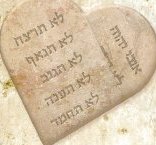“So there remains a Sabbath rest for the people of God. For the One who has entered His rest has himself also rested from his works, as God did from His” (Hebrews 4:9-10).

The Law Written on the Tablet of the Heart: Image from Samuel Bolton, The True Bounds of Christian Freedom (Banner of Truth)
This is the fourth installment in a four-part series. See Part 1 (the Sabbath as Moral and Mosaical) HERE, part 2 (the Sabbath in the Covenant of Works) HERE, and part 3 (Christ’s fulfillment of the Sabbath in the Covenant of Works and its Mosaical Elements) HERE. For a summary list of quotations by Owen see HERE. All Owen quotations are from John Owen, An Exposition of the Epistle to the Hebrews: Vol. II (Grand Rapids: Baker), Reprinted 1980.
John Owen’s doctrine of the Christian first-day sabbath hinges largely on his interpretation of Hebrews 4, and more specifically Hebrews 4:9-10: “So there remains a Sabbath rest for the people of God. For the One who has entered His rest has himself also rested from his works, as God did from His.” Owen understands “the one” of verse 10 as a reference specifically to the Lord Jesus Christ. Let’s dig a little into Hebrews 4 and see if that interpretation can be justified.
First, Hebrews 4:1-3a makes the case that the Israelites failed to enter into God’s rest because they lacked faith (and therefore obedience), while believers, through faith, do indeed enter into that rest. Second, in vv. 3b-4, the author grounds the original promise of rest in the work of God in creation. Third, in vv. 5-8, the author makes the case that Joshua, as the head of Israel, was not able to secure the promised rest; and that David, another head of Israel, acknowledged this in his own day as evidenced by Psalm 95:7-8. All of this is the author of Hebrews’ case that Sabbath remained relevant for believers under the New Covenant. This appears to be an essentially biblical-theological argument that Jesus Christ is the greater Israel/greater Joshua who has truly procured ‘rest’ for those who rest and trust in him by faith.
Next, we come to vv. 8-9. First (v. 8), since true ‘rest’ was never realized under the old covenant, the Sabbath promise of rest still stands. Therefore it would appear legitimate to infer, in v. 9, that Christ is the One who has truly entered into God’s rest. It therefore makes sense that vv. 14ff pick up on the theme (beginning with the word ‘therefore’ in v. 14) of Christ as the resurrected ‘Great High Priest’ who has entered into the heavens into the very presence of God.
Let’s take a moment to look at v. 9 in a bit more detail:The Greek verbs in v. 9, εἰσελθὼν (he who has entered [God’s rest]) and κατέπαυσεν (he who has rested), are both aorist, masculine, singular verbs. As masculine, singular verbs, the strict translation is “he who has entered” and “he who has rested.” The question that remains is, Is this a generalized ‘he’ referring to all believers, or a specific ‘he’ referring to Christ. Owen takes the latter view and my opinion is that the evidence bears this out. Next, the aorist tense indicates a past action with present ramifications. This rest has already been entered, and therefore he has already rested from his works in like manner to the original rest of creation. But, as the original rest of God had continued ramifications for his people, so this newly entered rest continues to have ramifications.
We cannot even begin to touch upon all of those ramifications here, but we will focus on the primary point picked up by Owen. Owen’s primary deduction from this passage is that Jesus Christ, having fulfilled the Covenant of Works in behalf of his people, and voluntarily taken the curse of covenant disobedience, for them, upon himself, has fulfilled the original import of the Sabbath. The original intent of the Sabbath, as revealed in creation, according to Owen, was that God promised Adam perfect rest and blessedness in his presence (think heaven) upon condition of obedience – work and then rest. After Adam’s failure, this principle of work before rest stays in force and is re-articulated by Moses in the Mosaical instructions regarding Israel’s sabbath. Yet Israel, like Adam, could not find rest on account of disobedience.
In the New Covenant Christ himself has finished the ‘work’ of the Covenant of Works perfectly; he has also finished the work of satisfying the demands of God’s justice in his death on the cross (hence ‘It is finished). Having done so, in his resurrection, he enters into a state of perfect rest and blessedness at the right hand of the Father. Yet there remains a sabbath-rest (or sabbatism) for the people of God.
This rest is ultimately realized as we, in Christ, rest from our own works. This entails a repudiation of our own righteousness as ‘filthy rags’ (to use Isaiah’s language) and a resting, by faith, in Christ as our substitute (both positively, in law-keeping, and negatively, in receiving God’s curse). We therefore, by faith, begin with rest and perform our works of obedience in light of what Christ has already accomplished in our behalf. The paradigm has been inverted: it is no longer work before rest, but rest before work. This is the principle of the ‘new creation’ which Christ has wrought in his resurrection.
This, says Owen, is the reason that the actual ‘day’ of rest is changed:
Now, as God’s rest, and his being refreshed in his work, on the seventh day of old, was a sufficient indication of the precise day of rest which he would have observed under the administration of that original law and covenant, so the rest of our Lord Jesus Christ, and his being refreshed in and from his works, on the first day, is a sufficient indication of the precise day of rest to be observed under the dispensation of the new covenant, now confirmed and established (pp. 409-410).
Therefore, it is fitting that the apostles should make it a practice to meet on the first day of the week rather than the last, since that is the very day when Christ himself entered into his perfect rest (Matt. 28:1ff, Mark 16:2ff, Luke 24:1ff, John 20:1ff, John 20:19, Acts 20:7, 1 Cor. 16:2).
In summary, for Owen, the institution of Sunday as the Christian sabbath, flowed from a contrast between the Covenant of Creation (or Covenant of Works) and the Covenant of New Creation (or New Covenant). In the first covenant, rest is entered into after the work of obedience has been completed. In the New Covenant, this work of obedience has been completed by a Representive – the Lord Jesus Christ. And Christ, having entered into that rest in our behalf, and as our Mediator, calls us to observe the first day of the week as a visible, weekly manifestation and reminder of his triumph over sin and the grave in the resurrection. We enter into rest in and by him alone, and therefore begin the Christian life with a principle of rest; and that principle is visibly manifested, one could almost say ‘sacramentally,’ in the observance of solemn, public worship on the first day of the week.
Owen’s own summary is this:
What account can we give to ourselves and our children concerning our observation of this day holy unto the Lord? Must we not say, nay, may we not do so with joy and rejoicing, that whereas we were lost and undone by sin, excluded out of the rest of God, so far as that the law of the observation of the outward pledge of it, being attended with the curse, was a burden, and no relief to us, our Lord Jesus Christ, the Son of God, undertook a great work to make peace for us, to redeem and save us; and when he had so done, and finished his work, even the erecting of the “new heavens and new earth, wherein dwells righteousness,’’ he entered into his rest, and thereby made known to us that we should keep this day as a day of holy rest unto him, and as a pledge that we have again given to us an entrance into rest with God? (p. 450).
Christ calls us to come to him and find rest (Matt. 11:28-29). He takes the heavy yoke of the Law of God upon himself so that our burden might be light in him. He has done the heavy lifting so that we may enter rest. We are privileged to celebrate his mighty work as we begin each new week. May this law of God be written on all our hearts.
We will make a few applications in a follow-up post.

